Overview
Overview of Product, Project and Company Background
I-Fabric Bag Company is a new company. It is aim to start establishing its business in UAE by introducing a new project “Foldable Fabric Trolley”. This project plan to be taken by four people. The idea of this project is to include a smart fabric bag to a trolley. It can be replaced with the plastic bags that used in supermarkets. This bag will be divided with compartment for different items. It is fold- able with wheels and alarm to take it back to the car. The product >has different items to be gathered whether it’s from inside the company or outside.
Opportunity Analysis
Based on some challenges that face our markets, there are some chances that identify potential opportunities. A number of European countries have bag taxes in some form and policies are there to reduce the use of plastic bags. Some cities have already banned plastic bags. Our society has become a consumer society in which there is an increase in the number of shoppers. Largest category of these shoppers are shopping from groceries. Most of those shoppers are using plastic bags to carry their goods. However, there is lack of awareness of the environmental effect of using plastic bags.
Opportunity statement
“Creating an environment friendly fabric bags and trolley replacing plastic bags that fulfills the needs of customers and helps in saving the environment.”
Project Schedule
To achieve our project, a Gantt chart has been created to schedule the project process. Based on our plan the project starts on April 17, 2016 and finished on May 5, 2016. The project is divide into three different phases. Phase one, analyze customer needs and technical requirements and its planned to take 5 days. Phase two, investigate the concept generation, evaluation, Selection and testing and it will take 7 days. Phase three demonstrate the product design, manufacturing plan and design for X and will start after phase two, as shown in Figure 1 (for clear figure, see appendix A).

Project Progress
Our estimated schedule for phase 1 has changed, based on our actual performance. In phase 1 there are a planned durations for each sub task. But after that there are some changed led to change the duration of these tasks. For example the sub task number 2 “Run Surveys and Interview” was planned to take 3 days, but in reality it takes 2 days, because of a delay in creating survey’s questions.
In phase 2 there are five tasks to be completed. Because of short time that we have, and because of some other external activates, phase 2 started late by one day, and in the middle of the duration we start to work in phase 3. It can be observed that there were changes in the planned schedule.
The tasks duration in Product Design, and Manufacturing Plan Phase are changed to be started early before the scheduled plan, because of time pressure. All the tasks finish before the estimated time in 2 days as shown in Figure 2. This phase finalize the lase stage of our project, in which it demonstrates the final product design, manufacturing plan and decision analysis, refer to Figure 2.
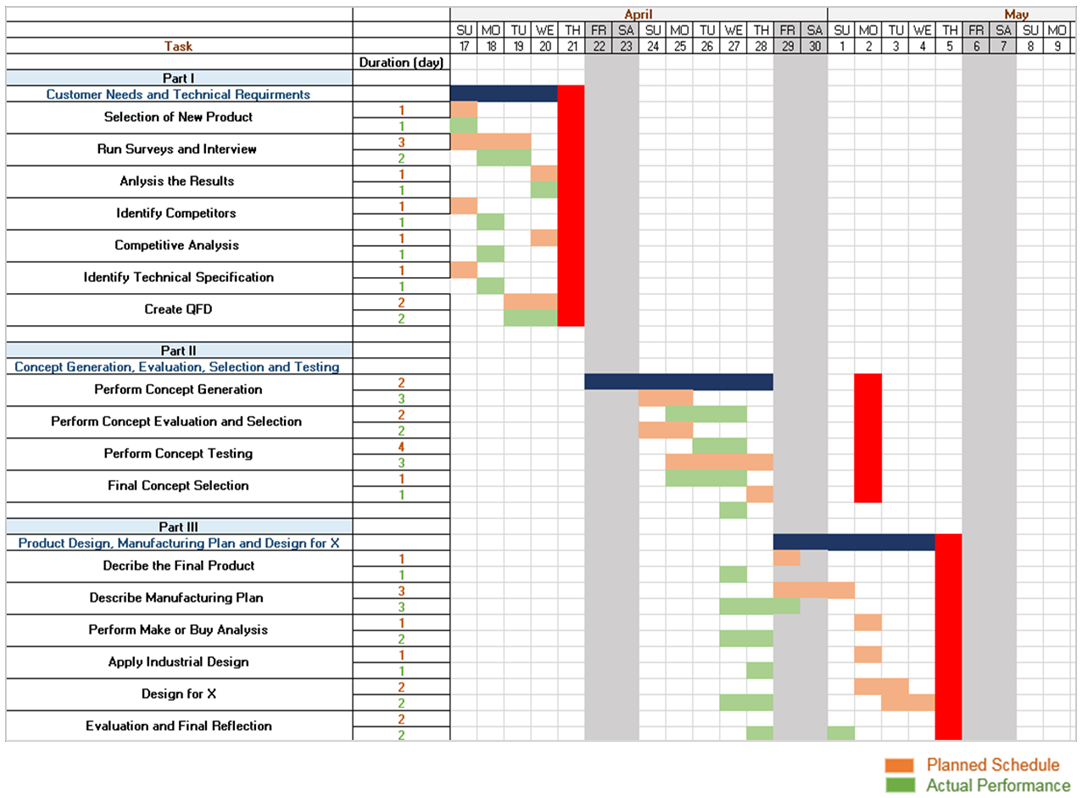
Mission Statement
The product’s mission statement summarizes the direction to be followed by the product development team. It provides assumptions and constraints under which the product will be developed.
Mission Statement
Be one of the world’s producers and providers of environment friendly fabric bags. Using our expertise, we seek to develop the most creative, innovative and profitable fabric bags to make the shopping experience more comfortable and easy for all the shoppers.
Description
The idea is a smart fabric bag which can replaced with the plastic bags that are used in the supermarkets. This bag will be divided into compartment for different items. It is fold-able with multi- direction wheels and alarm to warn or notify the shopper if he/she moves a certain distance away from it.
Benefit Proposition
Environment Friendly Fabric Bags for Shoppers. Fast & Simple Shopping. Shopping? Tired of carrying plastic bags? Our product will make it FUN for you.
Our product makes it easy for the shoppers to distribute, arrange and allocate their purchases in the fabric bag in a safe and convenient way.
- Affordable
- Innovative
- Smart
- Light
- Environment friendly
- Foldable
Opportunity Statement
Creating an environment friendly fabric bag replacing the plastic bags and fulfilling the needs of customers and assisting in saving the environment.
Key Business Goals
Our first key business goal is the product would be introduced in a well-known innovation exhibition such innovator. Secondly, we would have about 50% of gross margin. Thirdly, we would accomplish 60% of the market share by 2018 hopefully.
Target Price
Our target price is affordable. In other meaning, we would like offer our customers a competitive price taking into consideration the manufacturing cost and ensuring adequate profits out of the given price.
Target Market(s)
Primary
Our target market shall capture 50% of fabric bag sales in the primary markets such as the Environmentally Friendly markets. Moreover, it shall target the shoppers in the Super and Hyper markets.
Secondary
The secondary target of the product would the grocery stores shoppers.
Assumptions & Constraints
Here, we have addressed and highlighted the different assumptions and constraints of our product. The assumption and competitive advantage is that the fabric trolley shall be compatible with IOS/Android operating systems. As most of the shoppers are very concerned about the technology advancement in the smart phone industry. This advantage would certainly be catchy for them.
However, moving on to limitations part, our product would be power assisted. Looking at the technical features introduced to the fabric trolley, this would certainly a power source. This limitations was into consideration for future development and improvement as we are very concerned and committed in meeting our customer needs and making the shopping experience very comfortable for them.
Stakeholders
Our stakeholders for the sales operations would be consisted of Customers, Distributers and retailers.
Customer Needs
Identifying the customer needs is one of the significant steps in developing the concept. By knowing who our customers are, we will be able to understand their needs and make them happy. Knowing out potential customers very well helps us to work on how to convince with our product. So, to identify the customer needs, we should follow the three following bold steps:
- Collect the raw data from the customers
- Translate the raw data in terms of the customer needs
- Organize the needs into hierarchy
Collecting the data from the customers can be done by several methods such as: doing some interviews with the potential customers, focus groups, written surveys or observing the product in use. We decided to run a survey because of the short time. The interviews and focus groups will spend more time to gather the data from the customers, however, by running the survey we expected to have a satisfied and rapid result. The following subsection will present the survey, its results and its analysis.
Survey
The survey is one of the method that helps in gathering the quantitative data about items or products in a population. The qualtrics Survey Software which is available in Masdar institute website, was used to run our survey. The survey questions were more about the customers and what they use to carry their purchased items and how often the customers go to grocery or supermarkets. The survey questions are provided in Appendix A.
The target population for our product is anyone who goes to supermarket or any shop to get their needs such as housewives, students, employees, etc. The survey was distributed among 350 person through emails and WhatsApp. The response rate was 14.86 % which means that we got only 52 responses during two days only. We got the results of two days only because of the limited time and to present our works. The following figures show the results of the survey.

The result of question 1 shows that most of the respondents about 36 person are in age between
15 and 25 years since we sent the survey for most of the friends. Then, the second highest answer for the first question was people in age between 25 and 35 years because we ensure that the survey will distributed to the families as well.

The result of question 2 which was about the gender shows that 44 respondents are female and the remaining is male because we sent the survey for most of our female friends since most of the families depend on the housewives (the mothers) to bring the missing home items. It is true that the husbands (fathers) is buying the missing home items most of time but the more knowledge of these things is the female.

The result of question3 shows that 90% of respondents are students because as it mentioned before, the survey was sent to our friends who are most of them students.

The result of question 4 illustrates that around 83% of the respondents go to the grocery from two to four times weekly. However, 12% of the respondents prefer to go to the grocery from 4 to six times weekly.

The result of question 5 illustrates that 26 of the respondents purchase items that weighted 1-3 kg per week, and the remaining distributed between less than 1, 3-5 and more than 5 kg. So, the buyers go to the grocery 2-4 times and purchase what their home needed weekly.

The question 6 was about the type of bag or trolley that the buyers prefer to take for carrying their purchased items. So, the result was that 90% of the respondents use the regular plastic bags and the reason of that is the availability of regular plastic bags in most of shops, groceries, and supermarkets as well as the buyers might forget their own bags or trolleys in home.
The question 7 was about if the buyers would like to use a fabric trolley in case if the trolley is available. The result was positive, 54% of the respondents answered with YES and 34% of the respondents answered with MAYBE which means that if the fabric trolley enters the market as a product, there is a probability of its success.

However, we asked the buyers about the reason of not using the fabric trolley and their answer was shown in question 8 result. Most of their answer was that they don’t have it and others answered that the supermarkets provide only plastic bags. So, we could say that because of the lack of the fabric trolley availability, most people use the plastic bags.
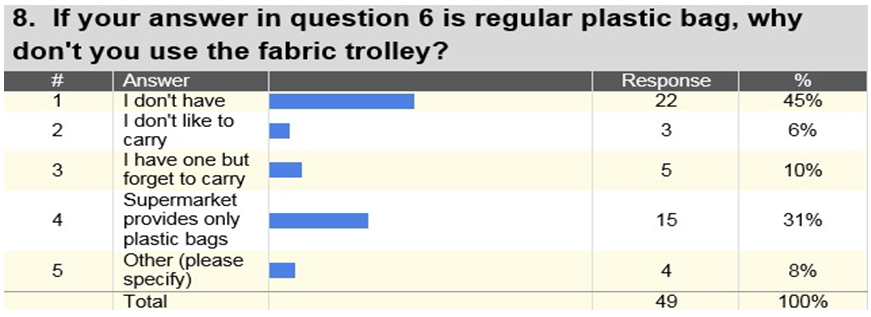
Question 9 was about the requirements of the preferred shopping bags for the buyers. We asked them about the movability of the bags and they liked it. Only 2% of the respondents said NO, however the remaining said YES. The buyers prefer to have moving bags to facilitate the buying process and because they prefer to drag the items and not to carry it to avoid any pain in their hands.

The question 10 was about another requirement which is the size of the bag. We provided three options with some examples to show for the respondent the scale of the bag. The options are small like small purse, medium like laptop bag, and large like trolley. 69% of the respondents prefer to have medium size of the bag.

The question 11 was about the flexibility of the shopping fabric bag/ trolley. 54% of the respondents think that the fabric trolley is flexible and 40% said maybe it is flexible.

The result of question 12 shows that most of the buyers prefer to drag one foldable trolley that includes several compartments rather than carrying a pile of separate plastic bags. We think that the buyers prefer the foldable trolley because of ease of storing as well. It will be easy to store one foldable trolley rather than a pile of separate plastic bags.
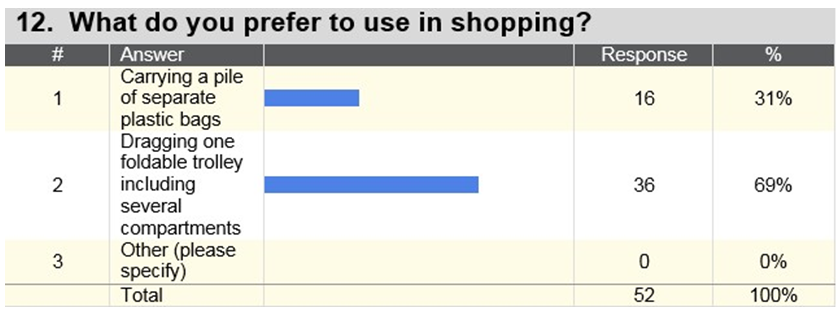
In question 13, we asked the respondents which one of the three options are fashionable and the answer was 79% of the respondents said that fabric bag/trolley is the most fashionable one.

Question 14 was about storing the bag, as we mentioned before, 69% of respondents prefer to store one foldable fabric bag rather than a pile of plastic bags which will keep a space for other usage.


Question 15 was about if the buyers will use the foldable fabric trolley to save the environment.
75% of respondents said YES for saving the environment which means that people start to go for the sustainable product and understand the importance of saving the environment.
So, the last step in identifying the customer needs is to organize the needs into hierarchy and this will be illustrated and explained in Quality Function Deployment (QFD).
Competitive Analysis
A competitive analysis is a critical part of the product making lifecycle. According to this evaluation, we can establish what will makes our product unique and therefore what attributes we play up in order to attract the target market.
In our case the main competitors were identified as follow, first the regular fabric bag which is made from polyester and comes in verity of shapes, sizes and colors, as shown in Figure 18.It can hold stuff up to 5 kg, its relatively cheap it can obtained by only 2 AED, in UAE an example of a famous fabric bag as shown in Figure 19, is the one which is sold in Carrefour and Ikea stores.

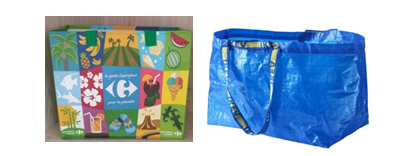
Furthermore, the second competitor is the foldable fabric bag, although it’s not popular in UAE it can be considered as one of our product competitors. The bag has a solid foldable frame as shown in Figure 20 it is made from Flax ,can be folded and hold up to 12 kg.It can be obtained from online websites such as Amazon. Its price is ranged according to its size and design, it’s usually start from 25 AED.

Next, the third competitor is the fabric bag with clips, which consist from single or multiple bags made from flax with plastic clips to be fixed in the trolley cart as shown in Figure 21 and 22.
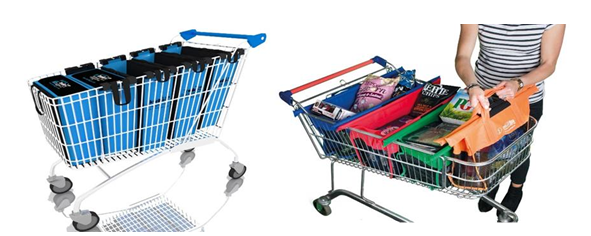

It comes in verity of shapes, sizes and colors and can hold stuff up to 50 kg. Similarly of the foldable fabric bag the fabric bag with clips it is not popular in UAE but it can be considered as one of our product competitors and can be obtained from online websites such as Amazon. Its price is ranged according to its size and design, it is usually start from 50 AED.
Finally the last considered competitor is the trolley shopping bag which is a fabric bag attached to it a metal wheel to facilitate its movability. It can be folded and handle up to 30 kg. It is made from polyester and metal and it is sold from 35 AED.

In addition to identifying all the competitors a further analysis was made in order to compare between them. As shown in the below table, the main three competitors were the plastic bag, the fabric bag (including both the foldable and the one with clips) and the shopping trolley bag. The comparison criteria were based on durability, movability, size, capacity, flexibility of usage, space allocation, aesthetic, ease of storage, environmental impact and availability. The criteria were concluded from the survey result and will used in the QFD.
Table 1: Competitors’ Analysis.
Likewise a detail analysis was made as shown in the below table, in order to identify the drawbacks if each competitor in order to avoid them in our design.
Table 2: Competitors’ drawbacks.
Technical Requirements
Target Technical Specifications
In order to get the target specifications the results of the survey were implemented along with Human Ergonomics taken into consideration, below is the table that shows each specification along with its targeted value:
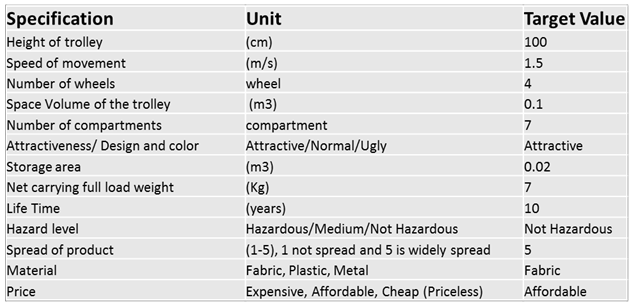
Height of Trolley, Speed of movement were based on Human factors analysis so that the height of the trolley with the handle extended is equivalent to the height of the elbow bent at 90 degrees (which is the best position for the arm while pushing/pulling the bag), moreover the speed of movement is equivalent to the average speed of human being movement so that the pushing or pulling of the bag will not be an obstacle or will not cause any delay in the movement.
Number of wheels is set to be standard four wheels which makes it easier to move the bag than if it was one or two and more than four might cause imbalance and might make movement even harder.
Space volume of the trolley is based on 1 meter height, 60 cm length and width so the total needed volume is around 0.36 m3
Number of Compartments is 5 so they can fit various types of purchases that the user would prefer to separate from other items.
Storage area of the foldable bag is approximately (60cm x 60cm x 20cm), and the net carrying load is 7 kg or more as we found from the survey results that most responds were that their average shopping weight per time is 3-5kgs.
Life time is targeted to be 10 years so the bag is durable and users will not be forced to change them frequently, also it is made of fabric so it’s an environmentally friendly material and will not cause bad effects such as the plastic, we are targeting wide spread of the product too make it easier for the customers to get them anywhere and anytime and finally to have it at an affordable price.
Targeted ideal values are as clarified in the table above and marginal values would be at ± 20% of the ideal value.
Quality Function Deployment (QFD)
Quality function deployment (QFD) is a method to help transform customer needs (the voice of the customer [VOC]) into engineering characteristics (and appropriate test methods) for a product or service. It helps create operational definitions of the requirements, which may be vague when first expressed.
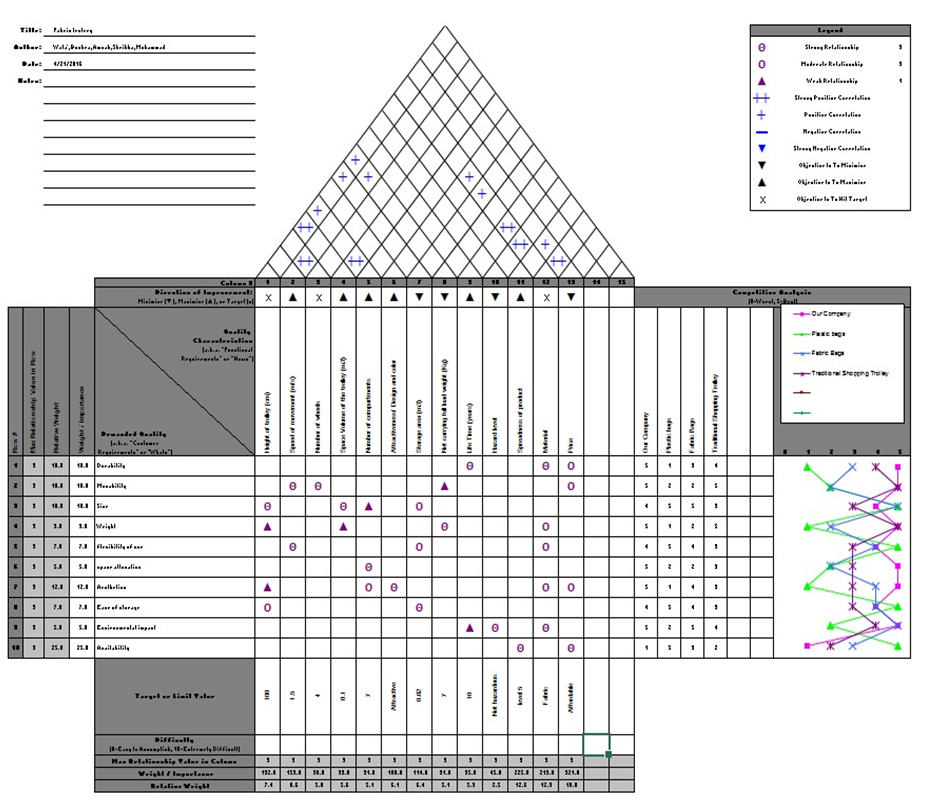
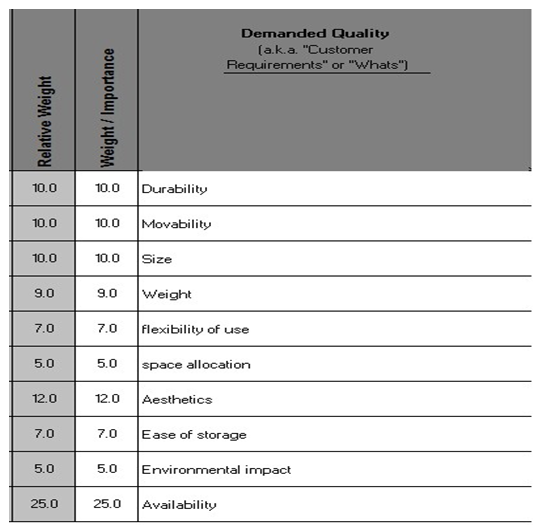
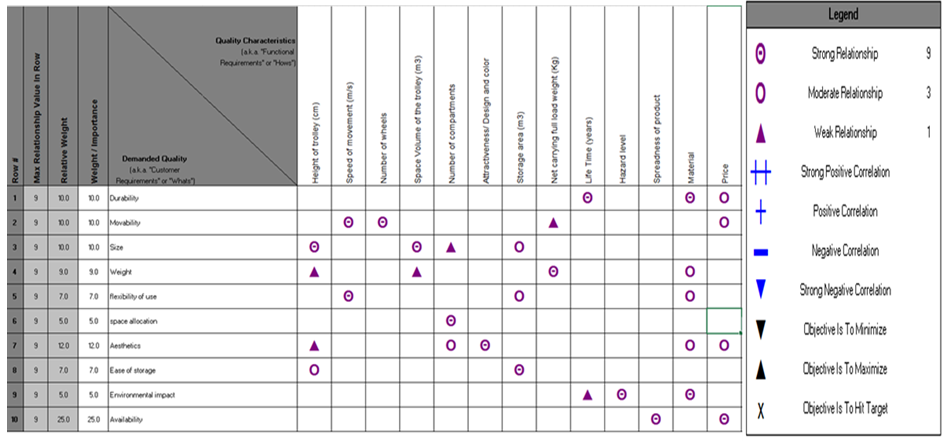
The table to the left shows the customer needs which were derived from the survey conducted, the weighting was based on a focus group decision and as shown Availability had the highest weight followed by Aesthetics, Durability, movability and size.
Below also you can find the relationships between specifications and customer needs.
And hereafter comes the competitive analysis, we can see that our product is doing well compared to the existing competitive products in the market, plastic bags varies between high strength points and low strength points, while the fabric bag and the traditional trolley comes in the middle as they represent the average product.
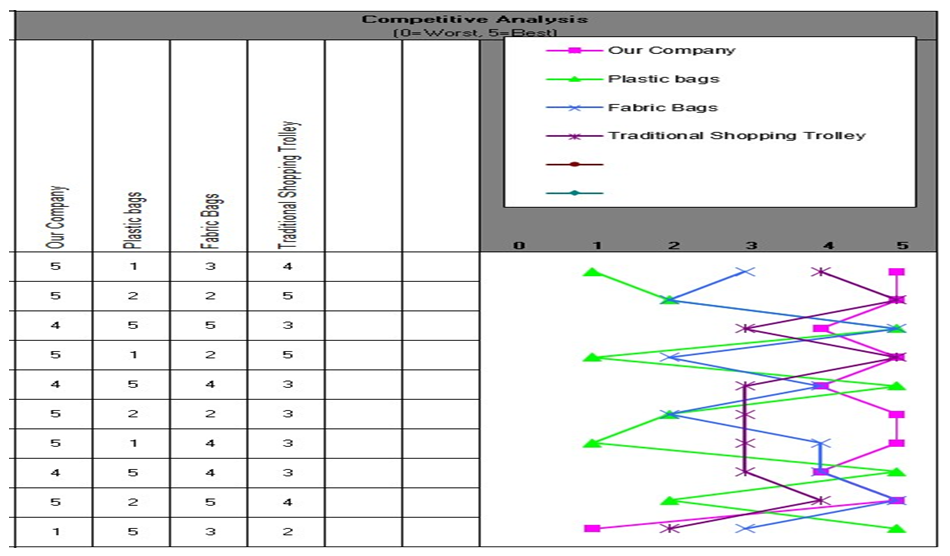
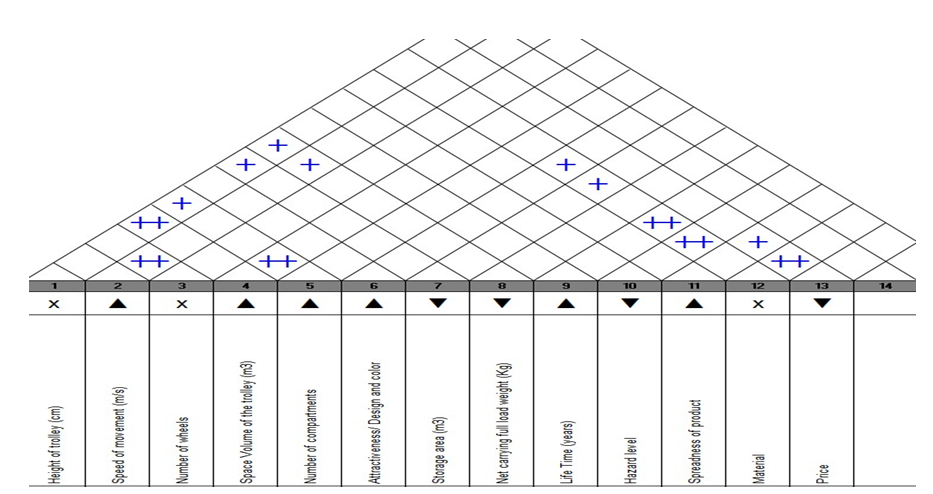
The graph above represents the interrelationships between the different characteristics of the product from the graph we can see that material is related to many other characteristics as well as the height of the trolley and price.
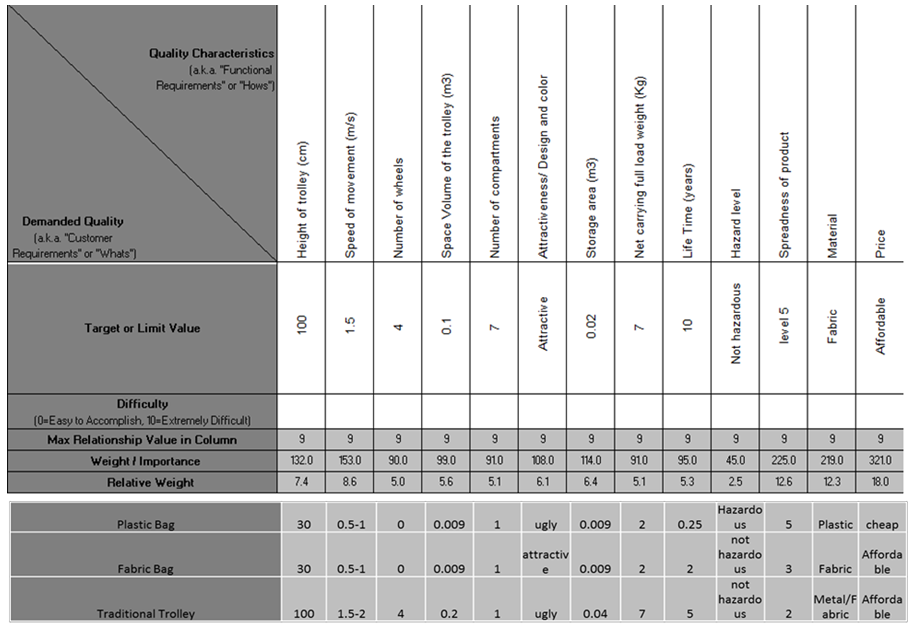
From the above table we can see that the ranking of the top most important characteristics is as follow:
- Price
- Spread of product
- Material
- Speed of movement
- Height of Trolley
- Storage area
- Attractiveness (Design and color)
Potential Sales
The success of every good is highly dependent on the customers’ reaction. There are some cases when the design was perfect, and the product combined technologies and innovations, however, as a result, failed to satisfy current market needs, and thus, became a failure. First and foremost, it should be stated that in order to meet the expectations of clients and orientate to innovations as well, it is essential to investigate the market and determine the sales potential of the good before it is manufactured.
This aspect should not be undervalued as it influences the process of future sales in a significant way. Furthermore, it can be considered as the most vital stage of the whole project. The determination of the market potential provides with an opportunity to evaluate the chances of the product to succeed on the market and will provide with a possibility to change some features of the product before it has entered the market.
The research on the potential sales can influence design greatly. For example, the high potential sales require more investments in terms of tooling, whereas low potential sales result in less investment for tooling. Fabric trolley designed in this project is orientated to satisfy the needs of people who care about the environment and value technologies and innovations. We suppose that this fabric trolley will substitute the half of the modern market as our mission and goals correspond to the Abu Dhabi’s 2030 vision regarding the creation of the sustainable city.
The environmentally friendly concept will influence potential sales beneficially. The price for the product will be affordable. Moreover, the fabric bag is needed to every person that does groceries. We suppose that there is hardly a person that does not buy plastic or paper bags in the supermarket. Thus, our fabric bag is a perfect option for substitution. This good is needed for every consumer. Moreover, the fact that smart fabric bag is not costly contributes to high potential sales.
Durability is a vital component as the trolley can function up to ten years. The convenience is another aspect that should be taken into consideration. According to our survey, the majority of people, namely 90%, use plastic bags for carrying products. People, who chose the plastic bags option were asked to answer the next question that was related to the desire to change focus towards the fabric trolley in case it was available. The statistics prove that people are environmentally friendly and value comfortable design as 54% of respondents answered positively, 34% hesitate, and only 12% refused to substitute the plastic bag with a fabric one.
Although the majority of respondents were females aged 15 to 25, it is worth pointing out that the potential customer is everyone who goes to the supermarket, values eco-friendly and convenient products. With the consideration of this fact, the smart fabric trolley will experience success on the market as it satisfies the needs of the customers, corresponds to their daily activities, and is affordable. The smart fabric trolley is durable, and thus, has a competitive advantage among the rivals. Taken into account the above stated information, the conclusion can be drawn that the potential sales are going to be high.
The detailed analysis of the competitors and evaluation of their strengths and weaknesses give an opportunity to adjust the design of our fabric trolley and to reduce the number of disadvantages, creating the innovative product. Innovations are not always related to the extensive usage of technologies. It is more about the ability to combine the advantages of different goods and represent them from a new perspective.
In order for the product to succeed on the market, customers need to be aware of it. In order to reach this objective, the management should invest in marketing and promotion of the product. In case, the good is advertised, there are more chances that the potential customers will be aware of the commodity and are likely to buy it. The product availability is another factor that affects sales potential volume in a significant way. For the customers to be satisfied, it is necessary to make sure that the products are available in every store where it can be purchased. The competition on the market plays a vital role for the sales as well.
The price, durability, convenience, design, and innovations are the most common aspects that the customer is looking for. For the product to succeed it should meet stated above requirements. It is worth pointing out that designing our product, namely smart fabric trolley, we took into consideration all these aspects and developed the product that has no analogues on the market and is sure to meet the expectations of the target group. Thus, the potential sales volume will be high. By 2018, we aim to accomplish 60% of the market share. The population of Abu Dhabi consists of over two million of people. The approximate number of customers is 666,000. The calculations of potential sales show the following data:
Potential sales = Potential Customer Number * Sales per Customer * Estimated Market Share; 666,000 * 129,605 * 0,6 = 51,790,158 AED. So, the potential sales according to our research are 51,790,158 AED.
Industrial design
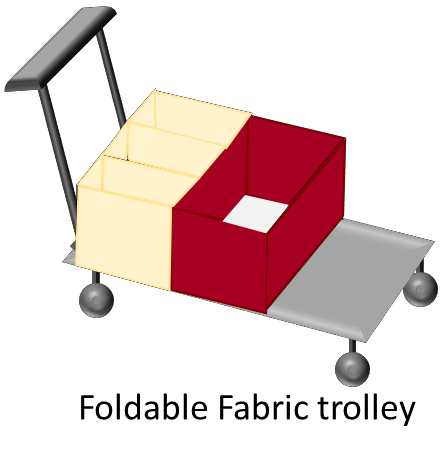
The design of the product should not only contain a technological aspect, however, should meet the needs of the customers making the product more convenient. The industrial design of the smart fabric trolley takes into consideration the desires of consumers and incorporates the advantages of the products that already exist. In the process of industrial design, the most important aspect is the creation of the idea. The product should satisfy the needs of the customer and be useful for buyers. This idea should take into consideration the following information:
- Who is the target group?
- Is this idea useful for the target customers?
- Is the idea unique and original?
- Does it demand significant investments?
The second stage is a conceptual work. This stage involves the fundamental ideas and logical relations between the manufacturer, developer, and buyer. Then, it is essential to make a visual representation of the good. As shown in the pictures, we have developed an accurate visual representation of our smart fabric trolley.
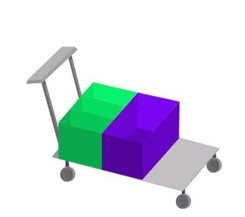
The 3D rendering is vital as well in order to virtually analyze and work on the model, to delete or add some features. The next stage is visualization and creation of the experimental model. The final phase of the industrial design sums up the previous stages of the product development and is directed to the creation of the model and final checking process. The prototyping stage of the project deals with the final model of the good that will be manufactured and delivered to the customers.
Concept Generation
Concept generation is the most critical step in the design process. It comes after identifying the customer needs and establishing the target specifications. So, we started to generate the concepts by first decomposing the product into sub-problems using the functional decomposition. The following figure shows the overall function followed by a figure shows the sub-functions.
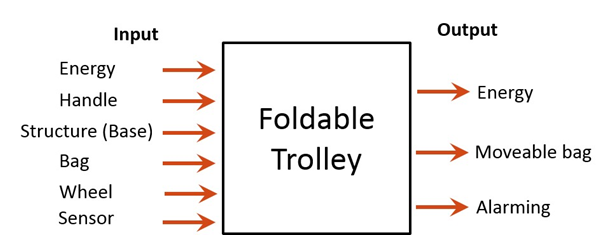
The above diagram illustrates the overall function of the foldable trolley. We put energy, handle, base, bags, wheels and sensor as input and the output is the energy, moveable gabs and alarming. We mean here by the energy is pushing/pulling the trolley or other source of energies that can be used to move the trolley such as electrical energy. The handle, base, bags and wheels are the components of the foldable trolley and each of these has its own function. The sensor is for alarming the buyers with the location of their trolleys.
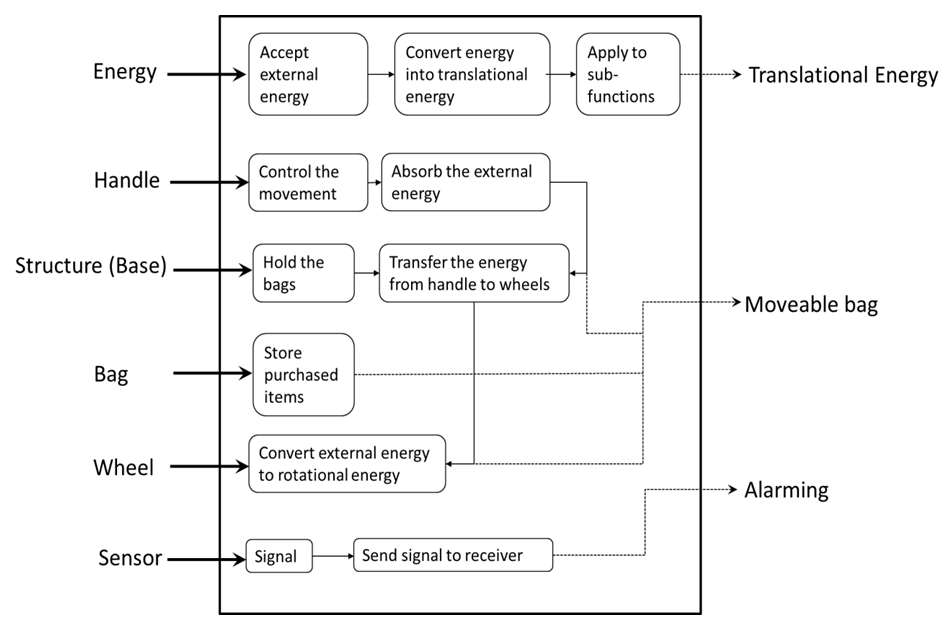
The function of the energy is to except any external energy such as pushing/pulling or electrical energy and then convert it to the translational energy and apply it to the sub-functions. The handle is for controlling the movement of the trolley. It will absorb the external energy and transfer it to the structure of the trolley. The function of the structure or the base is to hold the bags and combine other components as well.
So, the structure will transfer the energy from the handle to the wheels. The bags is used to store the purchased items. However, the wheels will accept the energy from the structure and convert it to rotational energy and not only from the structure, the wheels can accept any external energy. The sensor will be used to alarm the buyers or shoppers of the location of their trolley. So, the output will be a trolley has moveable bags and alarming sensor with applied translational energy. The following table will show some propose solutions for each critical sub- problems. These solutions were proposing based on the existing technology and some of them infeasible, we just added to see if we can do it or not because most of the unusual things leads to creativity.
Table 3: Critical Sub-problems and their Proposing Solutions.
The proposed solutions for energy are chemical, pneumatic, electrical, kinetic and hydraulic. Chemical, pneumatic and hydraulic are not feasible solutions because our product is so simple and no need for these kind of energy. We just propose all the possibilities that we can select later among them. We proposed for the movement, four solutions related to the type of the wheels and one solution is the belt that are similar to military tank but simple and smaller.
However, we focus on the wheels since they are more feasible to the trolley. Third critical problem is the storage of purchased items and this can be solved by using different types of bags and compartments. So, we propose five different solutions such as one big compartment as the usual trolley, multiple compartments for providing more space for storing the items, mix of bags and compartments like one compartment having many attached bags that can be removed or added at any time as needed, multiple bags which attached to each other and mixed configuration which will include a rubber band for bottles. The forth critical problem is alarming. We propose to have a GPS screen, or sensor connected to mobile apps, signal receiver, smart watch or car base. The following figures show the classification tree for each critical sub-problem with trimming the infeasible solutions.
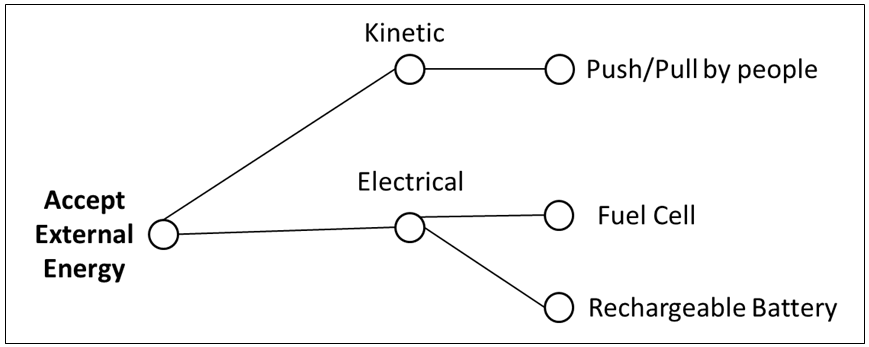
The classification tree for the energy source shows that we can use kinetic and electrical energies. What we mean by kinetic is the push/pull by people and the electrical such as fuel cells or rechargeable battery.
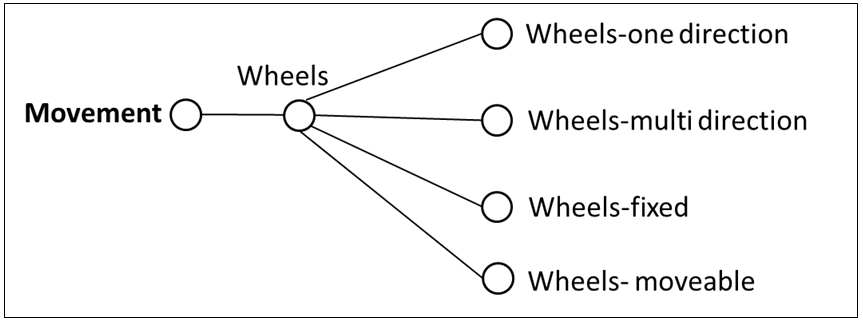
As we mentioned before, we trimmed the belt solution from the movement because we want simple and well-known solution, so we keep the wheels but with different type as shown in the above figure.
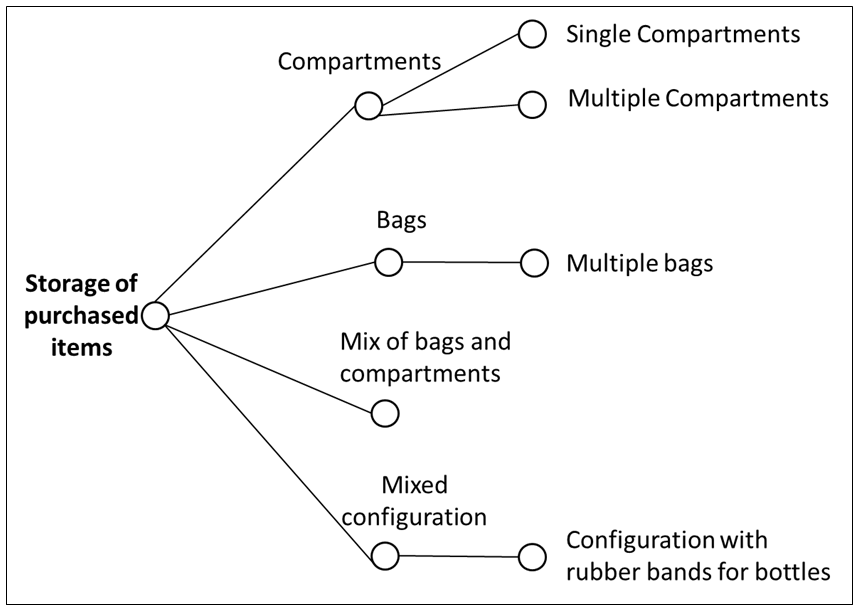
The above classification tree for storage shows the type of bags or compartments that can be used for storage. So, we can use single or multiple compartments or we can use multiple attached bags. Moreover, we can combine the bags and compartments to end up with more satisfied solution or use mixed configuration which is a compartment divided into different sections and there is rubber bands for bottles.
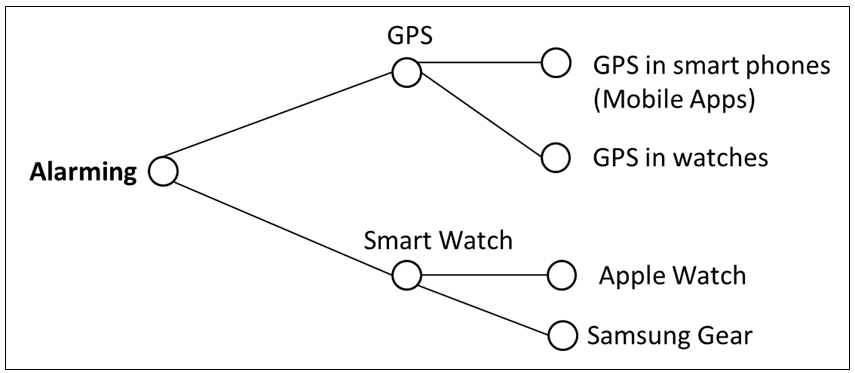
The above figure shows the classification tree for alarming. We keep the GPS and smart watch as the feasible solutions that we can do. The more simple our product and meet the need of the customer, the more the product will be successful.
So, we list the proposed solutions that we take it into account in a table and combine various sub- solutions into several rough product concepts. The following tables show the different concept combinations.
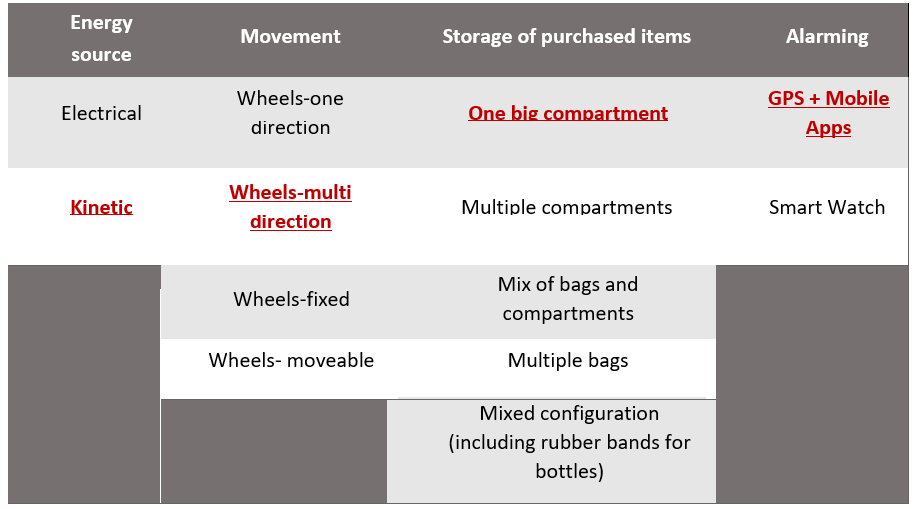
The above table shows the first concept combination which is combining the kinetic energy, multi direction wheels, one big compartment and mobile apps. Pushing the trolley by people is generating a kinetic energy which is delivered to the trolley. The trolley has flexibility of moving with the multi-direction wheels. It has one big compartment for storing the purchased items. It is provided with sensor to alarm the buyers of the location of their trolley. The sensor connects with the buyers’ phones by using mobile apps.
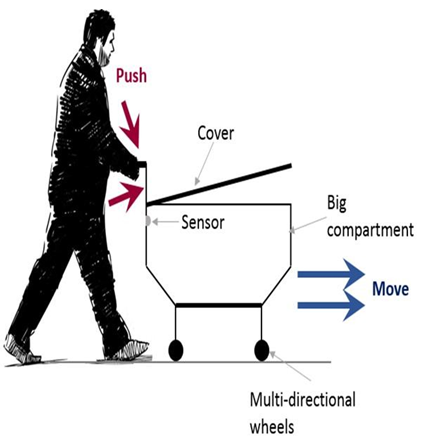
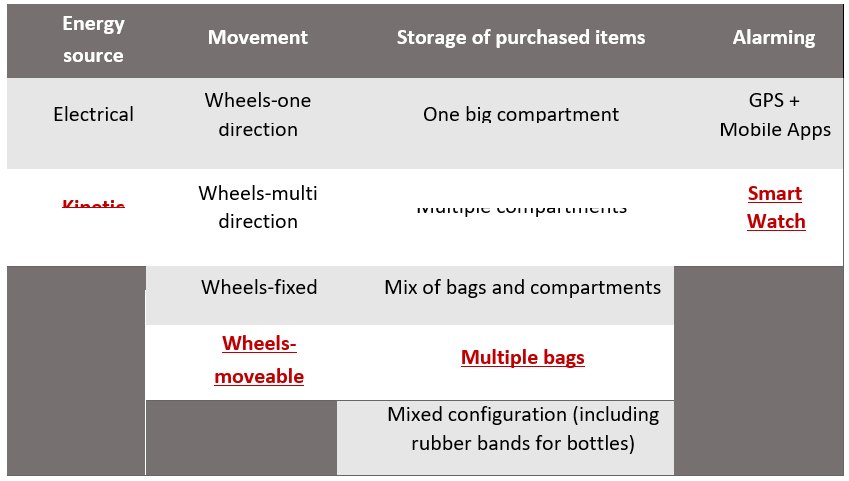
The above table shows the second concept combination which is combining the kinetic energy, moveable wheels (foldable), multiple bags and smart watch. Pushing the trolley by people is accumulating a kinetic energy makes the trolley moving. The trolley has multiple attached bags and moveable as well by adding foldable wheels to the bags. The trolley has sensors that connected to the smart watch of the buyers to alarm them of the trolley’s location.
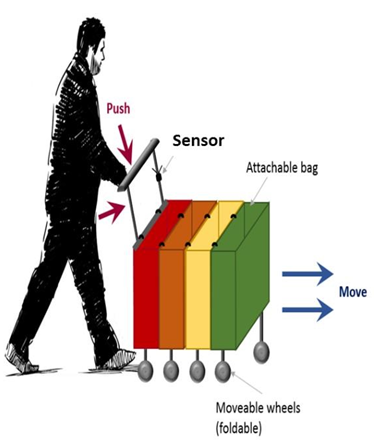
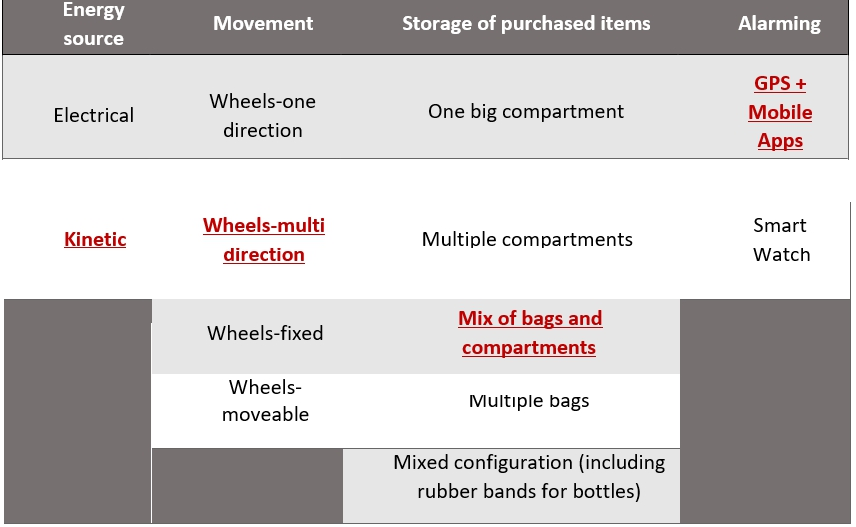
The above table shows third concept combination which is combing the kinetic energy, multi direction wheels, mix of bags and compartments and GPS. Pushing the trolley generates a kinetic energy. The trolley can move easily in multiple directions. Also, it comes with a unique structure by combining bags and compartments. Adding the GPS feature to make it even smarter.
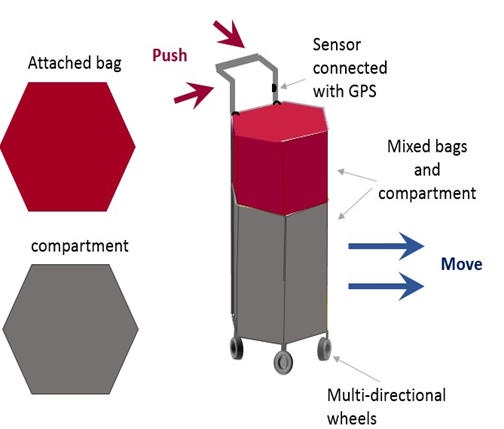
The above table illustrates one of the concept combination which is combining electrical energy, one direction wheels, mixed configuration and GPS. The trolley can move only in one direction which will work by using electrical energy. It has a mixed configuration plus customized bands which is manufactured especially for fragile items. Moreover, sensor that connected to the GPS of the car or phone will alert the shoppers if they leave without taking the trolley with them. It will lead them to the trolley location as well.
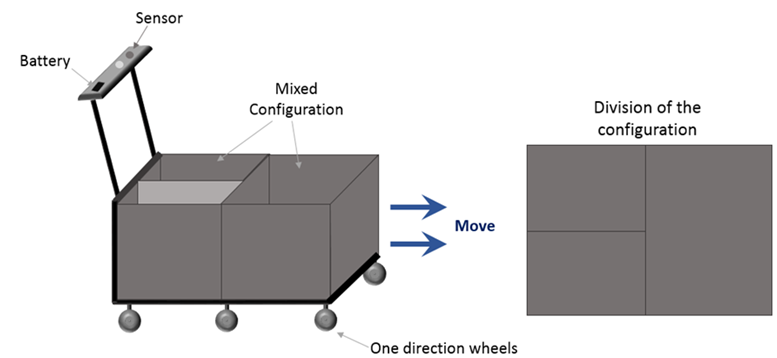
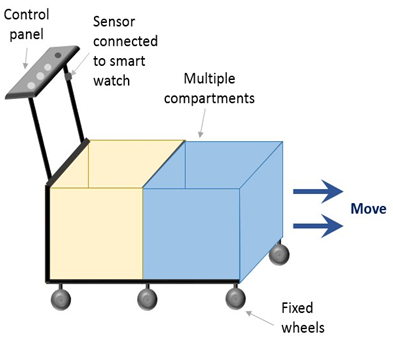
The above table displays the last concept combination that is combining the electrical energy, fixed wheels, multiple compartments and smart watch. The trolley has fixed wheels which will work by using electrical energy. It gives the shopper more space by adding more compartments. Moreover, it will connect the trolley to any smart watch by adding sensor.
Concept Evaluation and Selection
Concept Screening
After generating the five different concept, a Concept Screening was carried in order to select the promising concepts as well as improve the concepts.
The first step was to identify the criteria that we will use to distinguish the concepts and can itself generate significant debate. The criteria’s were concluded from both the first survey and the QFD. They were as follow:
- Ease of movability
- Flexibility of use (easy to opening, packing, unpacking)
- Aesthetic
- Ease of storage
- Ease of handling (how to control it in the supermarket)
- Separation between different items
The second step was choosing a reference concept, against which all other options will be compared, the existed shopping trolley bag was chosen a reference concept. This was a very helpful process, as it is much easier to compare two options than allocate a stand-alone score to a single option. The third step was to examine each concept and compares it against each criterion to give it a relative score this was done by a focused group consist of the team members.
The scoring scheme was as follow + if the concept was better than the reference, 0 if it was same as the reference and – if it was worse than the reference. Finally each concept then has its score totaled (net) to show its overall score and according to the net the concepts were ranked as shown in the below table concept 2, 3, 4 were chosen for further improvement and all the other concepts were excluded.
Table 9: Concept Screening.
Next, after selecting the promising concepts, concept 2 and 3 were combined by adding the pluses criteria on each concept the combined concepts has detachable bags (from concept 3) and the shape of concept
Concept 4 was improved by adding to its wheels that move in several direction to improve its movability.
Concept Scoring
Then after that a concept scoring was carried in order to select a single promising concept. The steps were somehow close to concept screening but with further detailing and were as follow. The first step was to identify the criteria that we will use to distinguish the concepts.The criteria’s were concluded from both the first survey and the QFD and the same as the concept screening criteria’s but with more detailing and they were as follow:
- Ease of rotation
- Ease of packing and unpacking
- Attractive look
- Dose not occupy large space after usage
- Ease of clean
- More than one compartment
- Separation between liquid and solids
The existed shopping trolley bag was chosen a reference concept again. The second step was weighting the selection criteria , the weighting was decided based on a focus group consist from the team members while considering the survey 1 result at the same time. Then the concepts were rated again and the weighting score for each concept were obtained by multiplying the rate of each concept by the weighting of the criteria. The scored were added and the concepts were ranked and the combination of concept 2 and 3 were chosen as seen in the below table.
Table 10: Concept Scoring.
Concept Testing
In order to predict the customer acceptance of the selected concept, a survey was conducted.
Survey
First we started by deciding the type of the survey and we determined to conduct an internet type survey since it is the fastest type and has the highest response rate, then we spread it through the social networks. Second, we designed the survey questions the questions were divided into two part the first part was a screening question and the second part consist of questions regarding the shape, features, price, predicted sales rate and area of improvements. Form of the survey is in appendix A.
The results of the survey
The total responses were 93 as shown in Figure 34 with having 87% response rate, which is much higher response rate than those in the first survey. We think because of spreading the survey link rapidly through the social networking rather than sending it only through the emails.
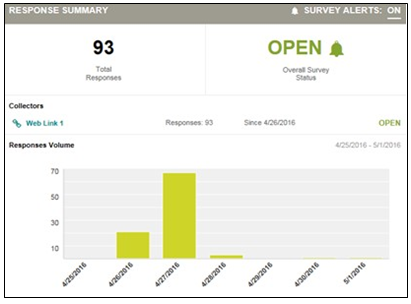
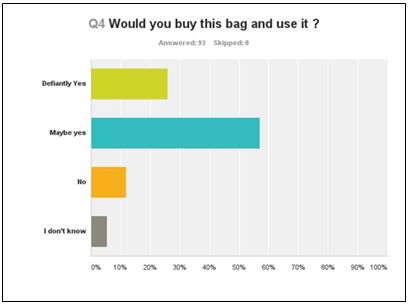
The results of the main questions were as follow, more than 57% answered that maybe they will buy the bag, refer to Figure 35, more than 38% are willing to pay between 50 – 100 AED as price for the bag as shown in Figure 36, finally more than 40% think that the bag need improvement in the shape and form as shown also in Figure 36. So, the improvement was made on the concept, is that instead of the hexagonal shape, the bag was redesigned as rectangle shape.
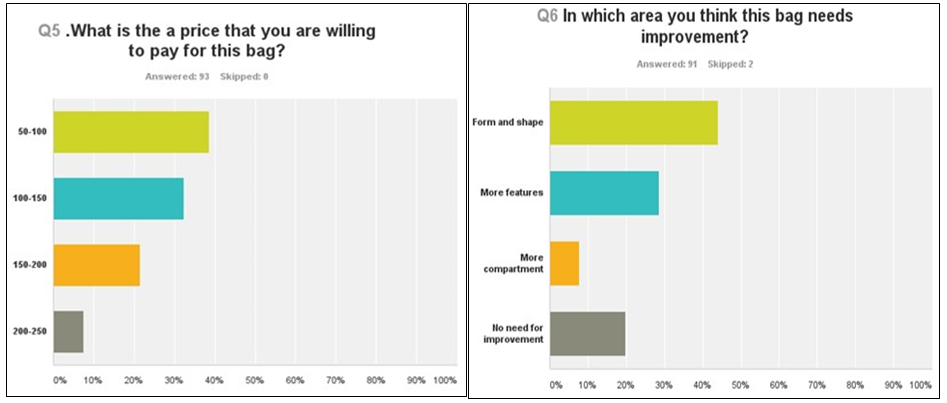
Final Concept Selection
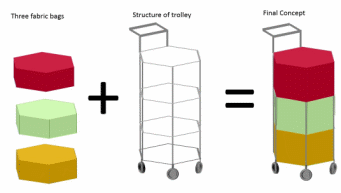
The above figure presents the final selected concept for the survey. We received some comments from respondents demanding enhancement in form and shape and other comments were asking for more horizontal length and less vertical height, so to enhance the shape we decided to change the shape into rectangle bags at wide diameters.
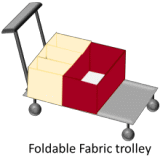
So the final concept would be rectangle, wider on length and smaller in height consisting of foldable frame, separated rectangle bags that can be connected together by clips.
Product Design
To translate the concept into a manufactural product, several elements should be considered that shown in the below figure.
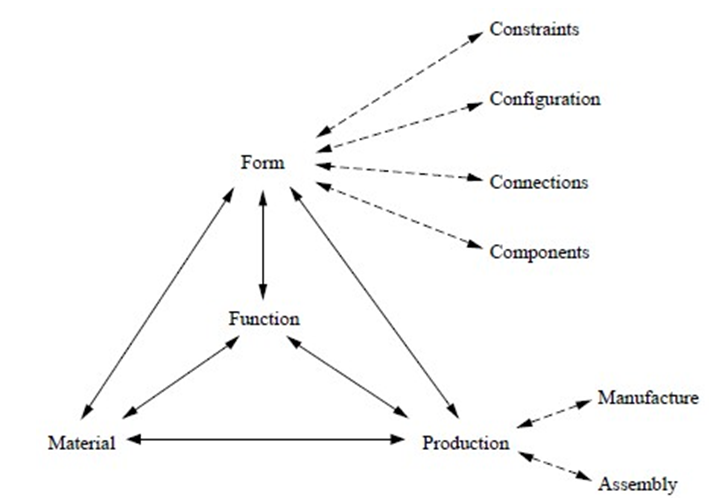
The focus of this figure is the product function and connected with the surroundings which are mutually dependent on each other. The form, material and production have been considered in the conceptual design to develop the function. However, in the product design, these elements should be considered to develop the form that meet the desired function as well as the material that are available. The upcoming sections will describe the form by defining the configuration of connected components, the material and technical specifications of our product as well as the product production with considering the function of the product.
Manufacturing Plan
There are two core levels created to determine the main components of the Foldable Fabric Trolley. Level 1, represents the two main components; bags and structure assembly. Level 2 characterize the structure assembly in sub components such as basket base, handle, screws, and wheels. On the other hand, the bags require bag base and clips, as shown in the below two figures.
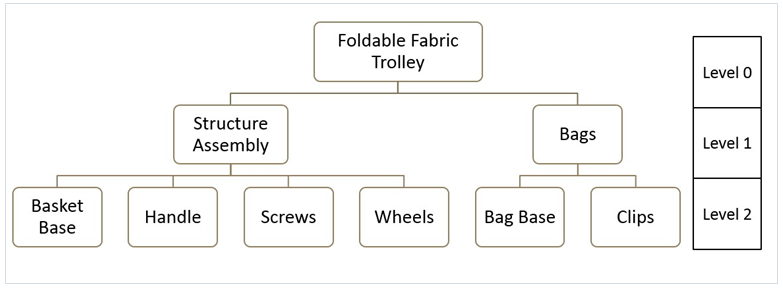
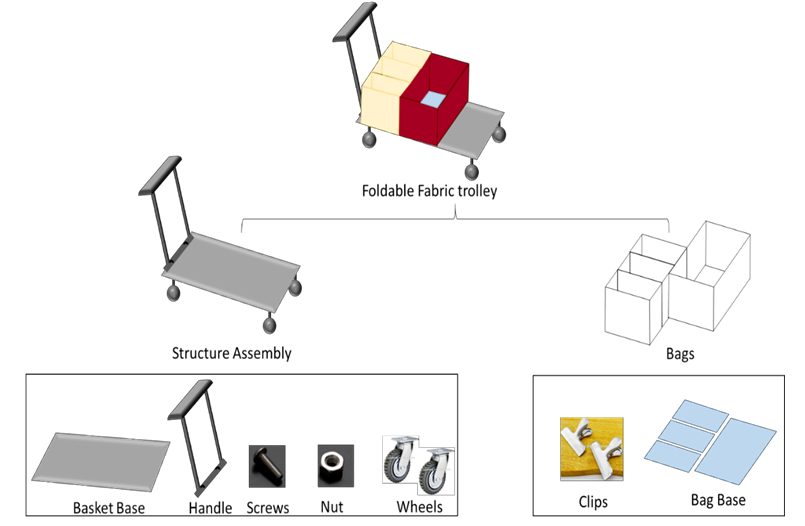
Bill of Materials
These components need a particular materials in order to produce them. For example, handle and basket base require a steel to build it. And based on the availability of these materials, it can be determine whether to make the component or to buy it form a suppliers, refer to the below table.
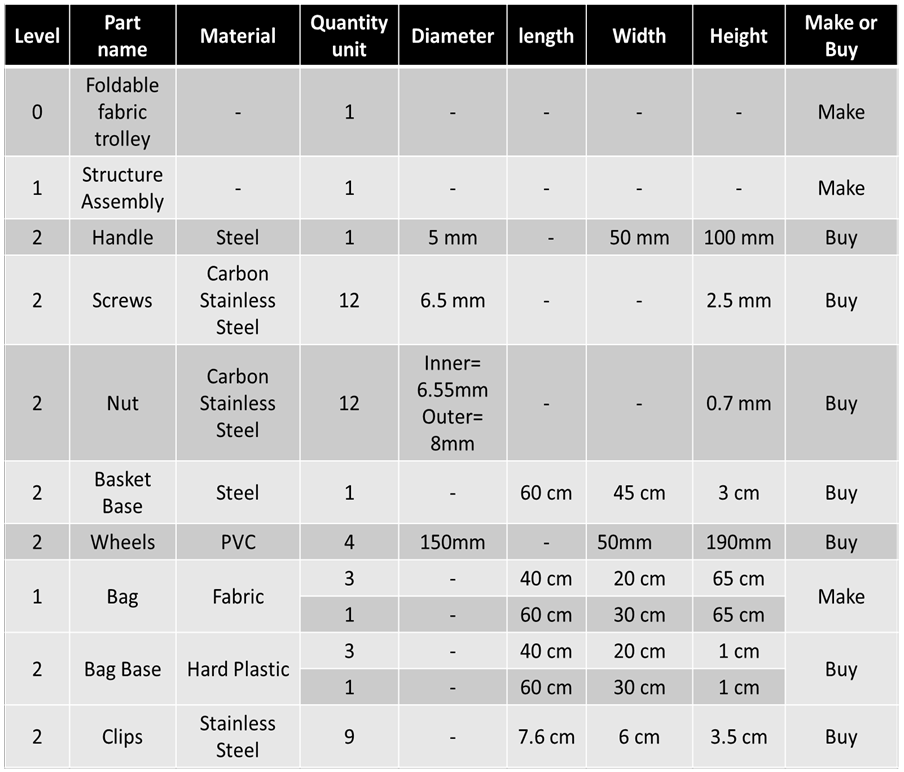
Make or Buy Analysis
This determination can be analyze from our ability to purchase the item or not? If we can make it or not? And is it cheaper or expensive? For example, Handel, Basket base and Bag base, we can purchase the items and we can make them, but it is not cheaper for us, so we decided to buy them form a supplier which is cheaper for us rather than make it. The below figures illustrate the make or buy analysis for our product.
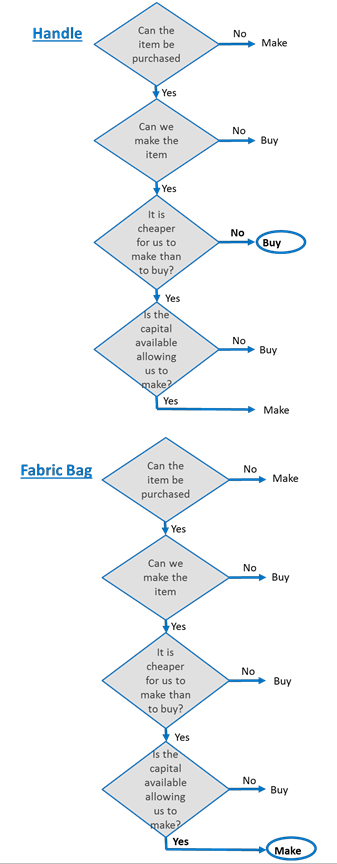
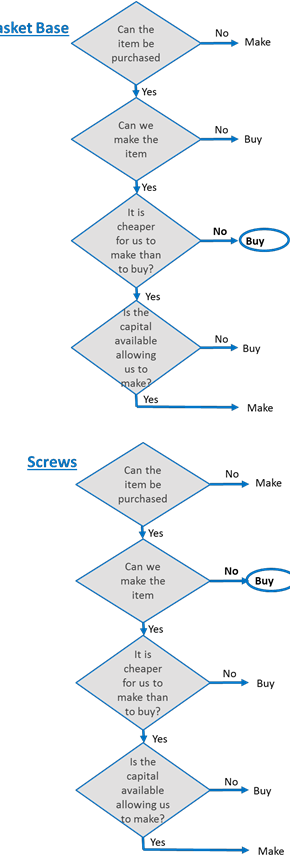
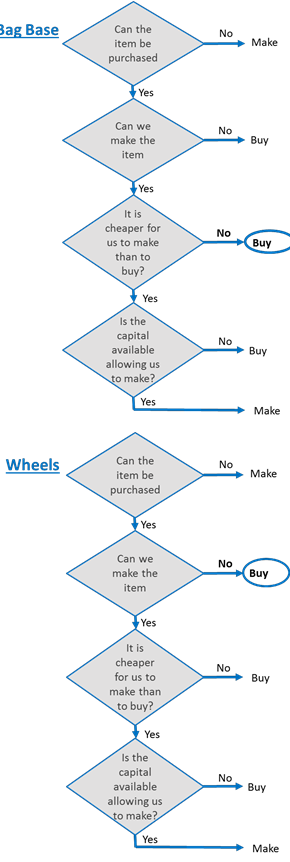
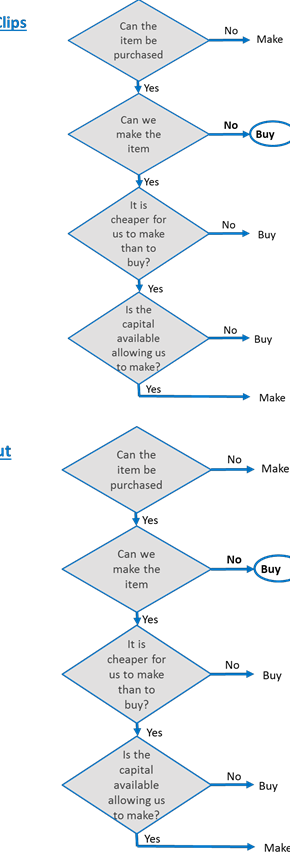
However there are a required criteria’s that assist us to decide which supplier we chose such as price and the quality of the items. For example, the below table shows the steel which the handle made of, it cost us 10 AED to buy it from a supplier, but it might cost us a lot if we buy it.
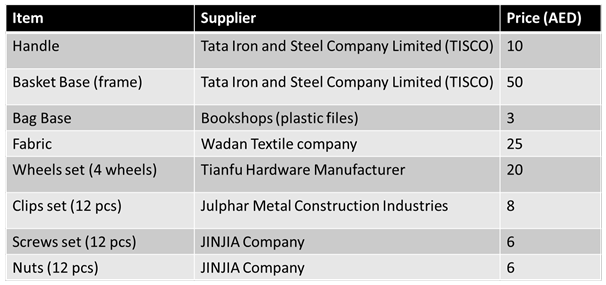
Cost Estimation
Table 11: Suppliers for Purchased Parts.
Material costs: 15 AED, from Alibaba.com
Purchased parts: 57 AED, the lowest cost was taken for each part.
Product Cost Breakdown
Labor Force
Estimated time for bag production is 1.5 hours
Table 12: Labor Force.
Total Cost of labor per bag is (17*0.5*1) + (14*0.75*2) = 29.5 AED
Tooling Cost
8 Working hours per day, 5 days a weeks, 45 weeks per year
Total hours production per year = (8*5*45) = 1800 hour
Sewing machine cost per bag = 1500/(5*1800) = 0.167 AED per bag
Total Tooling costs per bag = 0.167 + 0.033 = 0.2 AED per bag
- Overhead : 8 AED per bag
- Selling Expenses : 3 AED per bag
- Total Cost = Material costs + Purchased parts + Labor cost + Tooling cost + Overhead + Selling Expenses
- = 15 AED + 57 AED + 29.5 + 0.2 + 8 + 3 = 112.7 AED
- Profit : (Markup 15%) = 112.7 *0.15 = 16.905 AED
- Discount : (Margin 20%) = (112.7+16.905) *0.2 = 25.921 AED
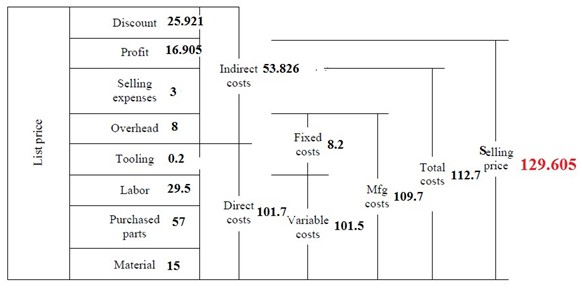
Design for X
Design for Environment
Up to 80%* of the environmental impacts are determined at the design stage and there are many aspects to be considered. One of them is source reduction where the goal is to use less virgin materials. The second aspect is design for recycling where the objective is to facilitate reuse. In our design both aspects were considered by applying the following features to our product:
Maximized use of recycled materials
- Products is designed with less mass (All the steel sections of the trolley were hollow sections instead of solid sections).
- Product is designed with longer life (more than single service such that the trolley can be used for domestic usage- fabric bags can be detached and used for different proposes like picnic bag)
- Reduce packaging (the product will be packed in a single package after production)
Design with less variety of materials
- Only 4 type of materials were used in the design.
Design for Assembly
In our design several guidelines for design for assembly were followed in order to maximize the ease and speed of assembly and they were as follow:
- Product is designed with a base component for locating other components.
- Trolley has large steel base and all other components like the handle the wheels were attached to it.
- Base is not required to be repositioned during assembly.
- Design components are mate through straight-line assembly.

Conclusion
We conclude that our product would hopefully have a great anticipated success in the coming years. The environment friendly feature would have a great impact on the sales operations supporting Abu Dhabi’s 2030 vision which aims to have a sustainable city. Furthermore, the technology features introduced to the product would also affect the sales potential positively. This is due to the smart society that we are living in, where everyone loves to have something unique or technology oriented gadgets that is fashionable and stylish in the same time.
Lessons Learnt
At this point of the project, everybody had done their tasks in a very good way. Nevertheless, we had the issue of time management, where we had a very short time for completing the last parts as we were engaged in completing the other obligations. In future projects, we seriously need to tackle such challenge in more appropriate manner.
Future Features
Following Apple’s approach in introducing a product and then later on introduce future improvements/enhancements to the existing product. We would like to offer future features to our product, where we will offer an electronic note to write down the grocery list and add a small sensor to detect the written items. Moreover, we are studying the motion sensor which will be installed on the fabric trolley bag which in turn would communicate with an application on a smartphone.
Appendix A
Project Schedule
Project Progress

QFD

Survey for identifying the customer needs
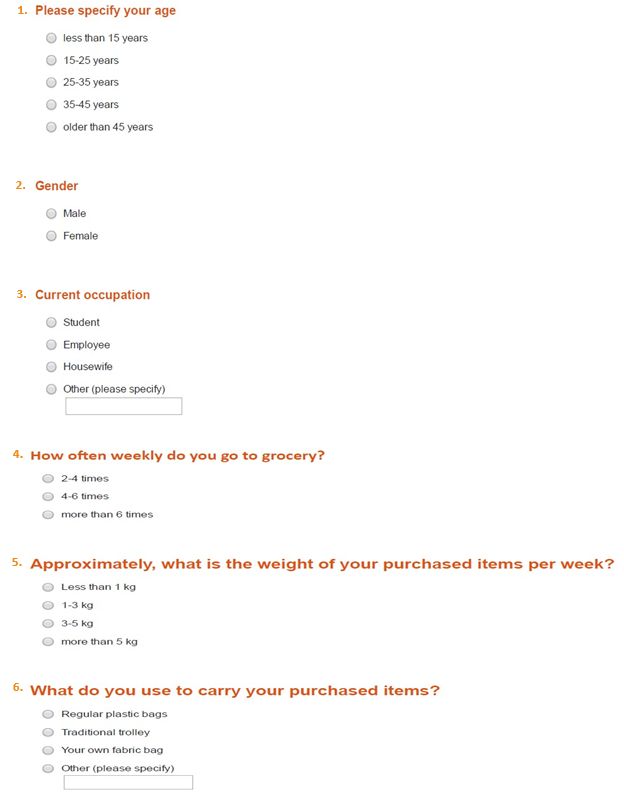
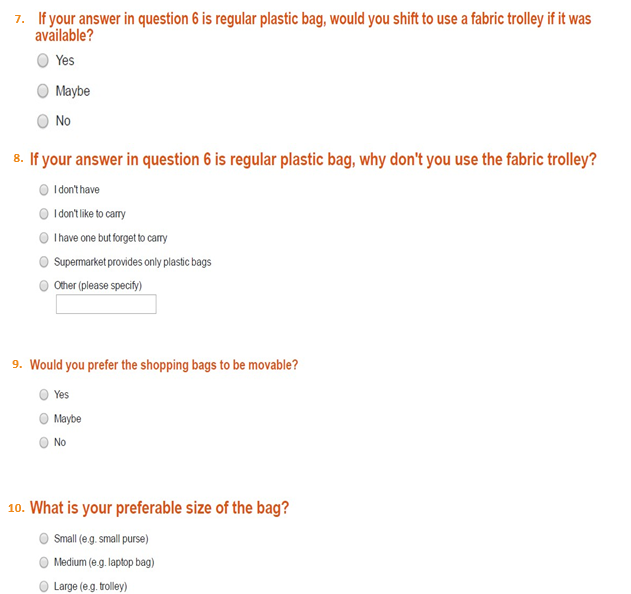
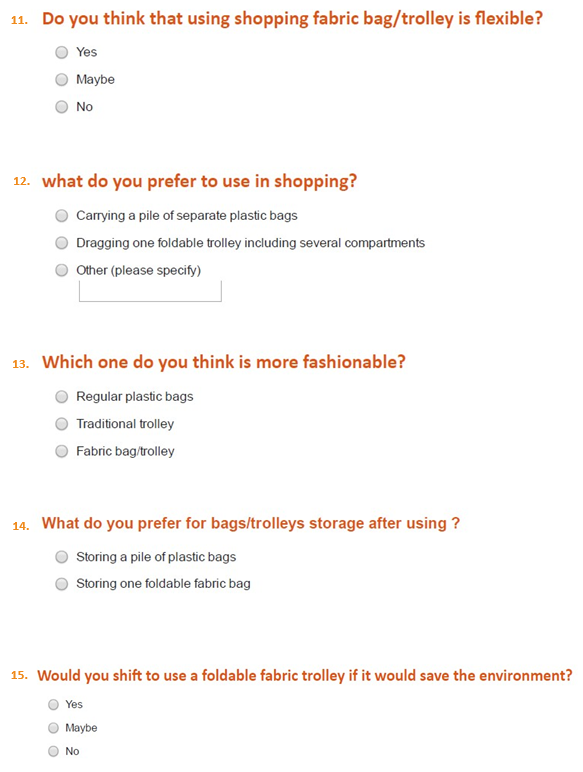
Survey for testing the concepts
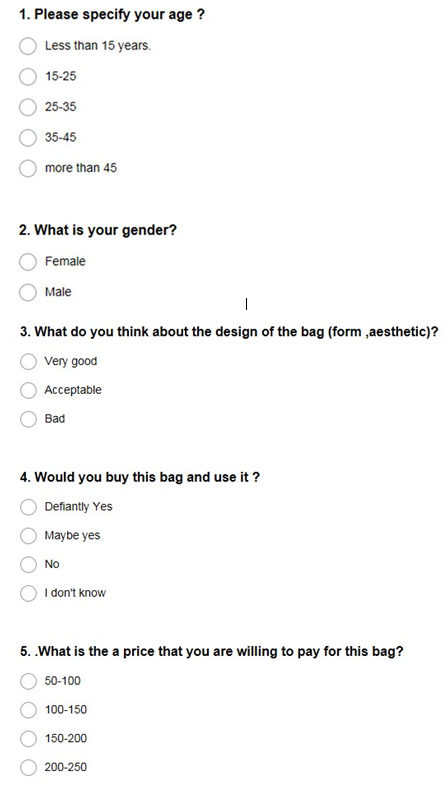
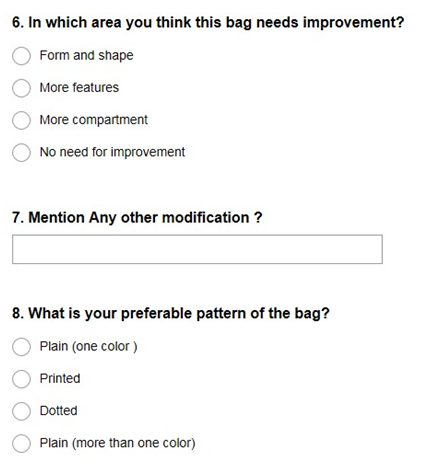
The following table shows the contribution of each team member in each tasks including report and presentation. The scale will be as follow: main, small, very small and none contribution.